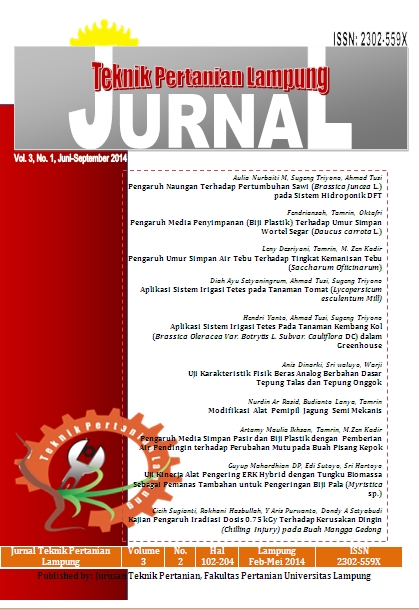[INFLUENCE OF SHADING ON THE GROWTH OF GREEN MUSTARD (BRASSICA JUNCEA L.) CULTURED IN HYDROPONIC DFT ( DEEP FLOW TECHNIQUE]
Abstract
The study aims to determine the response of green mustard (Brassica juncea L.) to the shade. This study used a randomized complete block design (RCB). Treatment consisted of T0 (control), T1 (one shade), T2 (two shades with one shade slightly slided to the east), T3 (two shades with one shade slightly slided to the west) and T4 (three shades). Shade in the form of plywood to the width and the distance between the shade of 12 cm are placed 50 cm above the gutter extends. Gutters along the 4 m with plant spacing of 10 cm is used as a nutrient. Comparison of fertilizer ( a : b) and water for 250 ml : 250 ml : 50 liter. Experiment used gutters as the growing media which were devided into three parts, namely B1 (section near the aerator), B2 (middle gutter) and B3 (the farthest part of aerator). Nutrient solution is circulated at flow rate of 1.2 cm/sec by using a small pump, which was also functioned as the aerator. Data was analyzed by using the analysis of variance test and LSD multiple comparisons. The results showed that T2 (two shades with one shade slightly slided to the east) produces the best respons with plant height (33,07 cm) and final weight (436,47 g). The result also showed that all environmental parameters (EC, DO, and pH) observed a long the gutter were not significantly different, indicating that the nutrient solution was quite homogeneous throughout the gutters.Downloads
Published
2014-09-30
Issue
Section
Articles
License
- Authors who publish with this journal agree to the following terms:
- Authors retain copyright and grant the journal right of first publication with the work simultaneously licensed under a Creative Commons Attribution-ShareAlike 4.0 International Lice that allows others to share the work with an acknowledgement of the work's authorship and initial publication in this journal.
- Authors are able to enter into separate, additional contractual arrangements for the non-exclusive distribution of the journal's published version of the work (e.g., post it to an institutional repository or publish it in a book), with an acknowledgement of its initial publication in this journal.
- Authors are permitted and encouraged to post their work online (e.g., in institutional repositories or on their website) prior to and during the submission process, as it can lead to productive exchanges, as well as earlier and greater citation of published work (See The Effect of Open Access).
Jurnal Teknik Pertanian Lampung

JTEPL is licensed under a Creative Commons Attribution-ShareAlike 4.0 International License.

